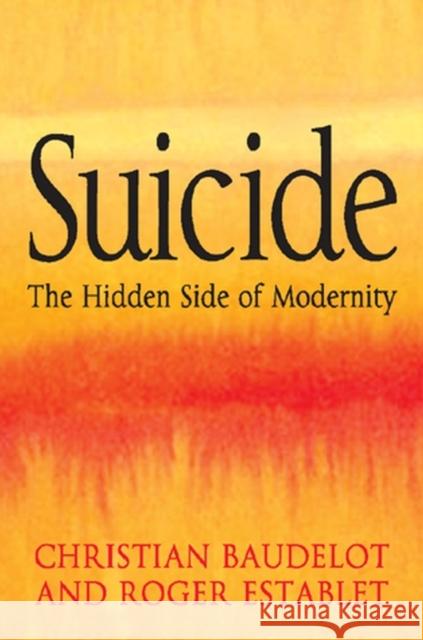Suicide: The Hidden Side of Modernity » książka



Suicide: The Hidden Side of Modernity
ISBN-13: 9780745640570 / Angielski / Miękka / 2008 / 224 str.
Suicide: The Hidden Side of Modernity
ISBN-13: 9780745640570 / Angielski / Miękka / 2008 / 224 str.
(netto: 119,90 VAT: 5%)
Najniższa cena z 30 dni: 90,09 zł
ok. 16-18 dni roboczych
Bez gwarancji dostawy przed świętami
Darmowa dostawa!
In this major new study Christian Baudelot and Roger Establet provide a timely and wide-ranging account of the changing nature of suicide in the world today.
Wydanie ilustrowane
"The authors are successful in using the admittedly rare phenomenon of suicide to explore the structure and dynamics of life in contemporary societies and reveal the some of the problems associated with marginalization in a (post)modern world."
British Journal of Sociology
"The general argument is illustrated throughout by a considerable amount of empirical data and rich case studies of a wide range of topics ... The willingness of two sociologists to accept the validity, legitimacy and value of different disciplinary perspectives on suicide is as refreshing as it is unusual. I am less pessimistic than Baudelot and Establet appear to be about the possibility of achieving a genuinely inter–disciplinary approach to researching and understanding suicide. If this book contributes to the realisation of this dream it will have served a very useful purpose indeed."
Sociology of Health and Illness
CONTENTS.
INTRODUCTION: SUICIDE AND SOCIETY.
The Anthropological Contribution.
Society Does Not Shed Light on Suicide; Suicide Sheds Light on Society.
Suicide: An Enigma To Be Deciphered.
1. DOES SUICIDE PROTECT?.
Suicide and Wealth Around the World.
In Rich Societies, Suicide Occurs in Poor Regions.
Growing Inequalities?.
2. Take–off.
India 1950–2000: An Economic Giant Is Born, Suicide Takes Off.
1980–2000: China Awakens and Suicide Rates Rise.
3. The Great Turning Point.
′England Brings Us a Surprise′.
France in the Nineteenth and Twentieth Centuries: The Meandering Evolution of Suicide.
1900–1948: the parallel between suicide and growth breaks down.
1949–1978: strong growth, stable suicide rate.
1979–1995: slower growth, more suicides.
England: Classic Evolution.
4. The Trente Glorieuses.
State–Orchestrated Growth.
Aggravating Factors ...
... And Protective Factors: Creative Individualism.
5. The Soviet Exception.
The World Leader.
The Social Femur and the Black–Out.
Suicide and Industrialization: A Forced March.
And There was Light: Long Live French Demography!.
6. The Oil–Price Shocks and Suicide Amongst the Young.
France: Young People at Risk, Old People Protected.
There Is No French Exception ...
... But There Are the Exceptions of Japan and Germany.
The End of the Italian Miracle and British Phlegm.
Taking the Social Dimensions of Age Seriously.
7. Suicide and Social Classes: An Overview.
The American Geography of Suicide.
French Départements: Income Tax and Suicide.
Ken Loach′s Devastated England Versus Blair–Thatcher′s Greater London.
Suicide and Social Milieu in France.
8. The Twentieth Century: Greater Protection for the Ruling Classes.
Detailed and Rich Data from the USA.
First Clue: Many More Social Bonds.
Second Clue: Making the Best of It.
Modern Forms of Poverty.
Towards a Cultural and Social Minimum Wage.
9. And Yet Women Survive.
The Chinese Exception.
Asia and the Pacific: Conjugal Difficulties and Female Suicide.
Revenge Suicide in New Guinea.
Japan Falls into Line.
Why Do More Western Women Not Commit Suicide?.
10. Conclusion.
Suicide: A Lesson in General Sociology.
Sociology Does Not Explain Everything.
Can There Be A Sociology of Exceptions?.
The Economy, Integration and Self–Esteem.
Acknowledgements.
Bibliography
Christian Baudelot is Professor of Sociology at l′Ecole Normale Supérieure in Paris.
Roger Establet is Professor Emeritus of Sociology at l′Université de Provence.
In this major new study Christian Baudelot and Roger Establet provide a timely and wide–ranging account of the changing nature of suicide in the world today. The suicide rate is soaring in the former Communist bloc, in India and in China, which now has the highest female suicide rate in the world. This rise coincides with those countries accelerated entry into a period of brutal modernization. In the developed countries of the West, suicide rates are rising fastest amongst young men and those social groups that are furthest down the social scale. How can we explain these trends and what do they tell us about modern societies?
The social impact of suicide has preoccupied sociologists from Emile Durkheim onwards. For Durkheim, the rising suicide rate was an effect of the rise of modernity and the individualism, growing affluence and increased anomie that accompanied it. Baudelot and Establet draw upon Durkheim and his successor Maurice Halbwachs to argue that classic sociological theories of suicide require some modification. The link between suicide, affluence and individualism is more complex: suicide rates do reflect broad social trends but they are also influenced by the structural position and lived experience of small social groups. The notion of social well–being is demonstrated to be a key factor in changes in suicide rates. Whilst it is well–known that sociology cannot explain why individuals commit suicide, the suicide of individuals and the micro–groups to which they belong can tell us a lot about the societies in which they live.
1997-2025 DolnySlask.com Agencja Internetowa
KrainaKsiazek.PL - Księgarnia Internetowa









